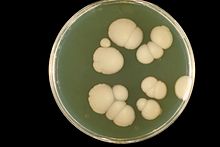Candidiasis
| Candidiasis | |
|---|---|
| Other names | Candidosis, moniliasis, oidiomycosis [1] |
 | |
| Oral candidiasis (thrush) | |
| Medical specialty | Infectious disease |
| Symptoms | White patches or vaginal discharge, itching [2][3] |
| Causes | Candida (a type of yeast)[4] |
| Risk factors | Immunosuppression (HIV/AIDS), diabetes, corticosteroids, antibiotic therapy [5] |
| Medication | Clotrimazole, nystatin, fluconazole[6] |
| Frequency | 6% of babies (mouth)[7] 75% of women at some time (vaginal)[8] |
Candidiasis, often called yeast infection or thrush, is a type of infectious disease. It is a fungal infection (mycosis). The disease is caused by any of the Candida species of yeast. Candida albicans is the most common species.[9][10]
Causes[change | change source]
Candida yeasts are common in most people. The yeast is usually controlled in the body. When the yeast grows without control, an infection happens.

A weakened, unhealthy, or young immune system may allow candidiasis to develop.[11] HIV/AIDS, cancer treatments, steroids, stress and not enough nutrients may cause candidiasis.
Antibiotic and steroid use are the most common reason for uncontrolled yeast.[12] Antibiotic kills some bacteria, and changes the balance of microorganisms in the body. This may allow the yeast to multiply.
Candidiasis in the throat and mouth[change | change source]
Throat[change | change source]
Esophageal candidiasis is an infection of the esophagus by Candida albicans. The disease happens in unhealthy people. Sometimes people will get the infection when they are treated with chemotherapy. People with AIDS can also get this infection more often.
One sign of esophageal candidiasis is painful swallowing. Weight loss can happen when a person has esophageal candidiasis for a long time.
Mouth[change | change source]
Oral candidiasis is a yeast infection of the mouth.[13] It is located on the mucous membranes of the mouth. It is caused by Candida albicans, Candida glabrata or Candida tropicalis.
Signs[change | change source]
Candida may appear as thick white or cream-coloured areas on mucosal membranes. The infected mucosa of the mouth may look inflamed. In babies the condition is called thrush. For babies, it is usually painless and causes no pain. Adults may experience discomfort or burning sensation.
Body parts[change | change source]
In healthy persons, candidiasis is usually a very small infection of the skin or mucous membranes.[9] These areas include:
- the mouth (oral candidiasis)
- the vagina or vulva (vaginal candidiasis or thrush)
- folds of skin in the diaper area (diaper rash)
- the nipples while breastfeeding
- the penis or foreskin[14]
- the armpit
- the ear
- the skin around or in the nostrils
- the ears
Candidiasis is a very common cause of vaginal irritation, or vaginitis. It can also occur on the penis or scrotum. In unhealthy patients, the Candida infection can affect the esophagus. It could get everywhere in the body. This would cause a much more serious health condition, a state called candidemia.[15] [16]
References[change | change source]
- ↑ Cite error: The named reference
Andrewswas used but no text was provided for refs named (see the help page). - ↑ Cite error: The named reference
CDCVaginal2019was used but no text was provided for refs named (see the help page). - ↑ Cite error: The named reference
CDCThrush2019was used but no text was provided for refs named (see the help page). - ↑ Cite error: The named reference
CDCCan2019was used but no text was provided for refs named (see the help page). - ↑ Cite error: The named reference
CDC2014RiskOwas used but no text was provided for refs named (see the help page). - ↑ Cite error: The named reference
CDC2014Otxwas used but no text was provided for refs named (see the help page). - ↑ Cite error: The named reference
Oral2014Statwas used but no text was provided for refs named (see the help page). - ↑ Cite error: The named reference
CDC2014Epiwas used but no text was provided for refs named (see the help page). - ↑ 9.0 9.1 Walsh, Thomas J.; Dixon, Dennis M. (1996), Baron, Samuel (ed.), "Spectrum of Mycoses", Medical Microbiology (4th ed.), Galveston (TX): University of Texas Medical Branch at Galveston, ISBN 978-0-9631172-1-2, PMID 21413276, retrieved 2022-04-12
- ↑ "Medline Plus at the U.S. National Library of Medicine". Archived from the original on 2010-11-13. Retrieved 2007-10-29.
- ↑ Odds FC (1987). "Candida infections: an overview". Crit Rev Microbiol. 15 (1): 1–5. doi:10.3109/10408418709104444. PMID 3319417.
- ↑ "National Candida Society Article". Archived from the original on 2010-11-13. Retrieved 2007-10-29.
{{cite web}}: CS1 maint: bot: original URL status unknown (link) - ↑ Medline Plus
- ↑ Wong, Jeremy (2008), Penile candidiasis - yes, yeast infection in men, archived from the original on 2010-02-23, retrieved 2009-01-20
- ↑ Pappas PG (2007). "Invasive candidiasis". Infect Dis Clin North Am. 20 (3): 485–506. doi:10.1016/j.idc.2006.07.004. PMID 16984866.
- ↑ Fidel PL (2002). "Immunity to Candida". Oral Dis. 8: 69–75. doi:10.1034/j.1601-0825.2002.00015.x. PMID 12164664.
Other websites[change | change source]
- National Institute of Allergies and Infections fact sheet on vaginitis/vaginal infections Archived 2007-10-22 at the Wayback Machine
- Oral Thrush Mayo Clinic
- DermAtlas candidiasis images Archived 2006-10-09 at the Wayback Machine
- InteliHealth page on candidiasis Archived 2006-08-31 at the Wayback Machine Presented by InteliHealth reviewed by Harvard Medical School
- Links to pictures of Yeast Infection (Hardin MD/Univ of Iowa)
- Treating a vaginal yeast infection Archived 2007-10-14 at the Wayback Machine
